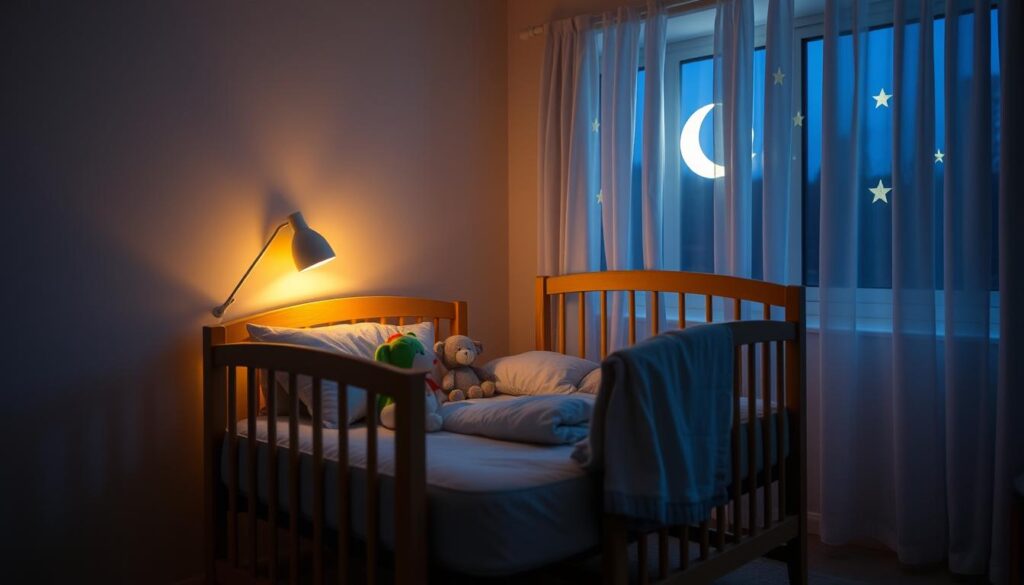As a new parent, I understand how important it is to help my baby sleep well. Good sleep is key for my baby’s growth and our family’s happiness. By setting a bedtime routine and making a cozy sleep space, I can help my child sleep better.
Key Takeaways
- Establishing healthy sleep habits is vital for a baby’s growth and development.
- A consistent bedtime routine signals to the body it’s time to sleep.
- A comfy and safe sleep space is essential for quality rest.
- Knowing your baby’s sleep patterns helps tailor their sleep schedule.
- Dealing with sleep challenges and regressions ensures your child gets enough rest.
Understanding Baby Sleep Patterns and Development Stages
As your little one grows, their sleep patterns and needs change a lot. It’s key to know these changes to make sure your baby sleeps right for their age and stage of development.
Newborn Sleep Cycles vs. Older Baby Patterns
Newborns sleep a lot, about 16-17 hours a day. But their sleep is broken, with many wake-ups for feedings. As babies get older, their sleep gets better, with longer stretches of sleep at night.
Age-Appropriate Sleep Requirements
- Newborns (0-3 months): 14-17 hours of sleep per day
- Infants (4-11 months): 12-15 hours of sleep per day
- Toddlers (1-2 years): 11-14 hours of sleep per day
Common Sleep Milestones
- By 3-4 months, babies start to have a more regular nap schedule.
- Around 6 months, many babies start sleeping through the night (6-8 hours).
- By 12 months, most babies are down to 1-2 daytime naps.
- Around 18-24 months, toddlers typically transition to a single afternoon nap.
Knowing these baby sleep patterns and development stages helps you set up a healthy sleep routine. It also helps spot any sleep regressions that might happen.
Creating the Perfect Sleep Environment for Your Baby
As a new parent, setting up a sleep-friendly space for your baby is key. The right temperature, lighting, and noise levels can greatly improve your baby’s sleep. Let’s look at how to create the ideal sleep environment for your little one.
Temperature and Lighting Considerations
Keeping the room at the right temperature is vital for your baby’s comfort. Aim for a cozy temperature between 68-72°F (20-22°C). Dressing your baby too warmly or keeping the room too hot can disturb their sleep. On the other hand, being too cold can make them restless.
The lighting should be soft and calming. Use blackout curtains or blinds to block out harsh light. This helps create a peaceful atmosphere for sleep.
Noise Management and White Noise Benefits
Babies often find the sound of the womb soothing. White noise, like a sound machine or fan, can mimic this. It helps mask outside noises and promotes a calm sleep environment, whether they’re co-sleeping or sleeping alone. Avoid loud noises that can wake them up suddenly.
Safe Sleep Space Setup
Make sure your baby’s sleep area is safe and free from hazards. Follow the American Academy of Pediatrics’ guidelines for a sleep environment. This includes using a firm, flat mattress and avoiding loose bedding or soft objects in the crib. Keep the area clean and clutter-free.
If you choose to co-sleep, do it safely. Follow best practices to ensure a safe sleep environment for your baby.
By focusing on these key elements, you can create a sleep-friendly environment. This will help your baby sleep well every night.

| Ideal Room Temperature | Lighting Recommendations |
|---|---|
| 68-72°F (20-22°C) | Soft, soothing lighting with blackout curtains or blinds |
Essential Components of a Successful Bedtime Routine
Creating a bedtime routine is key for your child’s sleep. A few important steps can make bedtime calm and peaceful. Let’s look at what makes a bedtime routine work.
Timing and Consistency Tips
Being consistent is key for bedtime routines. Follow the same activities at the same time each night. This helps your baby’s body get ready for sleep.
Choose a schedule that fits your family. Try to keep the same routine on weekends too.
Calming Activities Before Bed
Softer activities before bed help signal it’s time to sleep. Try a warm bath, gentle massage, or a calming story. Stay away from playtime or screens, as they can make it hard to fall asleep.
Managing Bedtime Resistance
Babies often resist bedtime as they grow. Start the routine slowly and offer comfort. Stay firm with your routine to help them adjust.
Avoid giving in to extra play or attention. This can make bedtime harder and hurt sleep habits.
Focus on the key parts of a bedtime routine. This helps your baby sleep well and feel rested. Sweet dreams, little one!

| Timing and Consistency | Calming Activities | Managing Resistance |
|---|---|---|
|
|
|
“Consistency is the key to success when it comes to bedtime routines.”
Navigating Common Sleep Challenges and Regressions
As your little one grows, you may face sleep challenges and regressions. These are normal signs of growth. Knowing these issues and having strategies can help you navigate these times. This way, your baby can get the sleep they need.
Conquering Sleep Regressions
Sleep regressions are times when a baby’s sleep patterns change. This can lead to more night wakings and disrupted nap schedules. These usually happen at 4, 6, and 8-10 months.
It’s key to stay patient and keep your sleep routines consistent during these times.
- Stick to your established bedtime routine, even if it takes longer to get your baby down.
- Consider implementing soothing techniques like white noise, gentle rocking, or pacifiers to help your little one self-soothe.
- Ensure your baby is getting enough daytime feedings and naps to support their overnight sleep.
Managing Frequent Night Wakings
Night wakings are common, often in the first year. Babies may wake for hunger, discomfort, or reassurance. Here are ways to help your baby sleep through the night:
- Establish a consistent bedtime routine to signal it’s time for sleep.
- Ensure your baby is getting enough daytime feedings and naps to support their overnight sleep.
- Consider using a white noise machine to help soothe your little one back to sleep.
Every baby is different. What works for one might not work for another. Be flexible and try different approaches to find what works for your family.
| Common Baby Sleep Challenges | Potential Causes | Suggested Solutions |
|---|---|---|
| Sleep Regressions | Developmental milestones, growth spurts | Stick to routines, use soothing techniques, ensure adequate daytime feedings and naps |
| Frequent Night Wakings | Hunger, discomfort, need for parental reassurance | Establish consistent bedtime routine, ensure adequate daytime feedings and naps, use white noise |
| Disrupted Nap Schedules | Developmental changes, overstimulation, inconsistent routines | Stick to age-appropriate nap schedules, create calming pre-nap routines, limit daytime stimulation |
Understanding common sleep challenges and having strategies can help your baby sleep well, even during changes.
Understanding Different Sleep Training Methods
Exploring sleep training methods can help you establish healthy sleep habits for your baby. These methods vary from gentle to structured, each with its own benefits. The goal is to find the best fit for your family’s needs and your parenting style.
Gentle Sleep Training Approaches
Gentle sleep training, like the Ferber method, helps your baby learn to fall asleep alone. It involves responding to your child’s needs and gradually giving them more time to sleep. This method aims to build your baby’s sense of security and independence.
When to Start Sleep Training
The best time to start sleep training depends on your baby’s age and development. Experts often suggest waiting until they are 4-6 months old. But remember, every baby is different. Watch for your child’s cues and talk to your pediatrician to find the right start time.
Tracking Progress and Adjustments
Starting sleep training is a journey, not a single event. It’s important to track your baby’s progress and adjust as needed. Celebrate small wins and be patient. With consistency and flexibility, your baby can learn to sleep well through the night.



